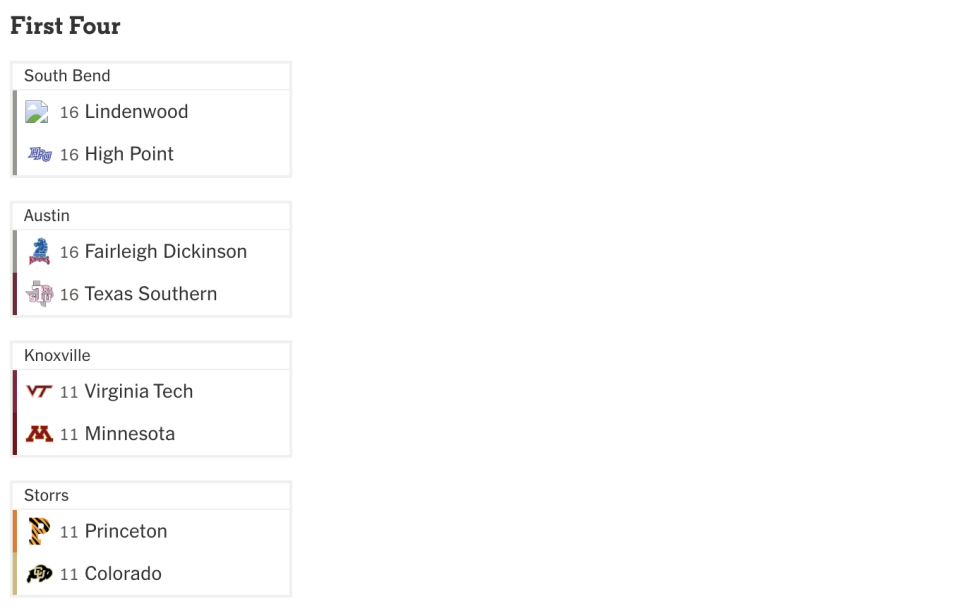Don’t look now, but we’re officially 30 days from Selection Sunday. How did it get here so fast, yet simultaneously how are we supposed to fit everything left in conference play? My brain is rattled.
Every day I look at my spreadsheets and my four-by-three whiteboard bracket and feel a little more akin to Charlie during the newsroom episode of It’s Always Sunny in Philadelphia, except Pepe Silvia is actually a real person in this scenario, and that person is actually the Utah Utes who I realized I forgot to put in my seed list at 1:13 a.m. … and it all comes back to that Mac.
To semi-quote “Always Sunny,” I’ve been dying to talk about it, let’s talk about the bracket, I wanna show you the bracket.
UCLA fallout
Thanks to an all-time performance from JuJu Watkins, we will not see an undefeated team make it to March, as USC took down UCLA 71-60 at the Galen Center Thursday night. Before even thinking of the ramifications for the bracket, you just have to marvel at a game like that. USC has been in a bit of a slump by the standards it set, recently suffering a setback to Iowa, and then they beat the No. 1 team in the country.
Trying to piece together how everything fit from a bracket perspective was frankly dizzying. Let’s summarize.
• UCLA drops to 5th on the seed list, the top No. 2 seed
• USC bumps back up to the No. 1 seed line
• Notre Dame takes the top seed overall
Why Notre Dame at No. 1 overall?
I wrestled hard with this one when trying to account for recent play (more on this shortly) as well as head-to-head matchups. Notre Dame’s victory over Texas during the ACC/SEC Challenge was a decisive factor for placing Notre Dame higher than the Longhorns.
Also note that Notre Dame hasn’t lost since the start of December, winning by less than double digits just once (Clemson) out of its past 17 wins. Particularly with UCLA falling and the head-to-head over Texas, the argument is pretty strong for the Irish as the best team in the country at this moment.
Then factor Texas beating South Carolina last weekend and winning nine straight games since the first game against the Gamecocks, which warrants placing Texas over South Carolina by a slim margin.
You could make a case for UCLA to remain a No. 1 seed, but the cases for the first three teams are too strong. The Bruins are phenomenal, and I expect them to make a run back to the No. 1 seed line, but UCLA unfortunately lost one of its best arguments for being a No. 1 seed and is no longer the lone undefeated team.
USC and UCLA meet once more in the final game of one another’s inaugural Big Ten season, this time at Pauley Pavillion, arguably the most important game of both teams’ seasons.
How does recent play factor?
I’ve been asked a few times in comments on recent bracket and bubble watch articles about two teams that are on different seed lines despite similar resumes.
Perhaps the biggest aspect that threw me for a loop from the selection committee last season was how much they valued recent play. I spent most of last year’s process leading up to the first Top 16 reveal solely seeding based on a program’s entire body of work. That’s still the majority of the job, but I’ve been trying to factor in the recent play as well to better show a bracket in line with how the committee lands.
For frame of reference, the most important aspect when I build the bracket is total resume: who have you beaten, who did you lose to, how competitive were losses.
But when determining between a seed line with two teams that have similar total bodies of work, the team playing better recently is far more likely to be seeded higher, even if losses to the other team were competitive. While it’s good to lose close, a loss is still a loss and has a negative factor.
When looking at NC State and Tennessee last week, I had NC State higher due to its recent performances. Tennessee picked up a massive statement win over UConn, but was 4-5 (without a Quad 1 win) since the start of January before beating UConn. The Wolfpack were 8-1 in that same stretch, including a Quad 1 win over Duke. The Volunteers had a notably tougher stretch, and all five losses to NET top-25 teams. But again, a loss is still a loss.
I’ve put a ton of emphasis on strength of schedule, similar to last year, but adding recent play as a stronger factor (consider that the last two to four weeks) has made it a bit more uncertain on some of the closest cases. I’ll be curious to see how the selection committee has processed this on Sunday during the Top 16 reveal.
The frightening middle of the Big Ten
One of the biggest questions I have for the committee: How does it approach valuing and seeding the middle of the Big Ten?
Nebraska beat up on Minnesota early in Big Ten play but lost handily to Indiana and Iowa recently. But, hey, the Cornhuskers also have key wins over Michigan State and Maryland — both Quad 1 opponents.
Indiana beat Iowa earlier in the season, but it lost to Minnesota and Oregon. The Ducks beat Iowa, Indiana and Michigan State in a row to close January, looking primed to take a step, and then they lost by 30 to Michigan. Oregon’s win over Baylor in nonconference (Quad 1) is crucial on its resume. Illinois defeated the Ducks earlier in conference play and separated itself from the pack to a degree.
Speaking of Illinois, that’s one of Minnesota’s key wins as well as defeating Indiana last weekend. But the Gophers also lost to Iowa recently, and that aforementioned beat-down at the hands of the Cornhuskers still stings.
There are a lot of solid to good teams in this conference, but they’ve somewhat hurt one another in league play, which is to be expected. How the committee estimates this group isn’t something we’ll gain insight into until March 16 … and that certainly keeps me up at night.
Texas taking hold
Now 25-2 as they stack quality wins like Halloween candy, the Longhorns hold all the cards to earn a No. 1 seed.
As we’ve detailed throughout the past few weeks, the SEC has looked increasingly more likely to earn two of the top four seeds. Texas has come to play, winning nine straight games since losing to South Carolina in mid-January, including avenging that defeat in Austin on Sunday. Coach Vic Schaefer’s squad has also reeled off six Quad 1 wins in that stretch, made even more impressive considering that only five teams in the country have six or more Quad 1 wins for the entire season.
With a looming Sunday primetime showdown against LSU, also in the hunt for a No. 1 seed, we’re getting another crack at the top billing shifting hands.
Could Richmond pop the bubble?
Is your program on the cusp of an at-large bid and struggling to stay afloat? Well, unfortunately, I do not bring good tidings for you as the Richmond Spiders and the A-10 tournament could wind up being the reason they’re on the outside looking in.
Richmond is a delight to watch play, running modern concepts, sharing the ball at a high level and killing teams with their shooting and what it opens. Every player who logs double-digit minutes takes and makes 3-pointers at a rate that warrants guarding. Though they won’t often win one-on-one or beat opponents without a screen off the dribble, you can’t get caught off guard at any point against the most efficient team in the country.
Yes, you read that right: Richmond leads the country in true shooting percentage, which accounts for shots beyond the arc and free throws. To add even more nuance, the Spiders have the nation’s highest field goal percentage at 51 percent and also lead the country by shooting 60.2 percent inside the arc.
Add this recipe to Richmond’s resume:
• Beat Oklahoma State (Quad 1 win)
• Beat Fairfield and Columbia (Quad 2 wins)
• Played Texas and Alabama close, showing competitiveness they’d need in the NCAA Tournament
Let’s say Richmond were to lose in the A-10 tournament despite being on track to win the regular season. This team is still in the field, and could easily slot in as a No. 10 seed even if things went awry. If the Spiders don’t wind up with an auto-bid, which they’re currently projected to receive, that means one less spot in the field with a conference unlikely to snag two bids doing just that.
Alabama’s big stretch
Coach Kristy Curry’s 12th season in Tuscaloosa is shaping up to be her finest, reaching 20 wins for a fourth-straight season. The No. 21 Crimson Tide have been ranked much of the season — the first time they’ve been in the Top 25 since 1999.
Alabama is a talented veteran team, starting four upperclassmen, including three seniors worthy of all-league honors and capable of making it to the WNBA.
The Tide picked up key nonconference wins against Richmond and Michigan State, both Quad 1 games. More significant wins have come in SEC play against Mississippi State and Ole Miss, placing Alabama in the top six of the conference standings. It’s worth noting that both of the Tide’s losses to South Carolina and Texas came without star guard, Sarah Ashlee Barker.
Now fully healthy, they face Texas A&M, Tennessee, Auburn, LSU and Oklahoma to close the year. They’re already knocking on the door for hosting in March, but with a strong stretch to close the regular season, they could snag a No. 4 seed or higher for the first time since 1998. Alabama is rock solid, and I sense there’s another gear it can get to.
The Bracket Central series is part of a partnership with E*TRADE.
The Athletic maintains full editorial independence. Partners have no control over or input into the reporting or editing process and do not review stories before publication.
This article originally appeared in The Athletic.
USC Trojans, Notre Dame Fighting Irish, UCLA Bruins, South Carolina Gamecocks, Richmond Spiders, Alabama Crimson Tide, Texas Longhorns, Women’s College Basketball, Bracket Central, Women’s NCAA Tournament
2025 The Athletic Media Company
EMEA Tribune is not involved in this news article, it is taken from our partners and or from the News Agencies. Copyright and Credit go to the News Agencies, email news@emeatribune.com Follow our WhatsApp verified Channel




